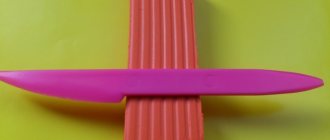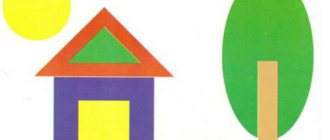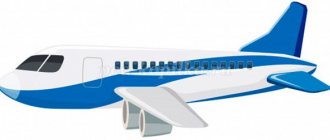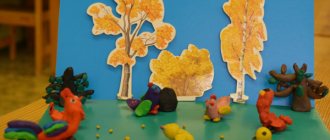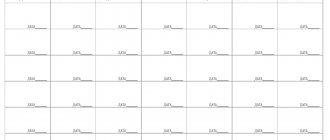Middle group. Junior preschool age. Children 4 - 5 years old
Summary of a modeling lesson in the middle group “Sonyushki-Pelenashki” Goal: to instill in children a love of folk art through artistic and aesthetic development. Objectives: teach children to create original compositions in matchboxes, sculpt swaddle dolls in cradles. Introduce the type of folk doll - diaper, explain the meaning...
Summary of a modeling lesson in the middle group “Jolly Snowmen” Summary of organized educational activities Educational area: “Artistic and aesthetic development”
Section:
“
Modeling ” Topic:
“Funny Snowmen”
Age group: average Purpose: Increasing children’s interest in making a snowman from plasticine. Tasks:…
MOLDING IN THE MIDDLE GROUP
Detsky sad.Ru >> Electronic library >> Family and children >> Children's creativity >> Features of the plastic form created by children of the middle group
Children of the fifth year of life differ in their development from children of the previous age. Their muscular system has become sufficiently strong, their vocabulary has expanded, and therefore the regulatory role of speech has increased. Children begin to identify some functional characteristics of objects, which facilitates the image process. They became more attentive during the teacher’s explanations and during the lesson, but the results of the work still differ little from what they did in the second younger group: when depicting objects, proportions are violated, there is no clarity in conveying the form, parts are not firmly held together. This happens because children do not adequately master the methods of representation; they do not have a clear idea of objects, their shape and structure.
Learning Objectives
The teacher continues to cultivate a stable interest in modeling, develop the activity of thinking and imagination, and coordination of hand movements. Teaches how to sculpt with the whole hand and fingers. Clarifies ideas about the shape of objects, their structure, proportions and details, teaches how to convey these ideas in modeling. For example, that a person’s head is round, that his face has a nose, mouth, and eyes. A hat may be worn on the head. The doll's body can be oval or cone-shaped, and the arms and legs are depicted as cylinders; the head is small compared to the body. To a greater extent than in the previous group, the aesthetic perception of form, a sense of rhythm, symmetry, and proportions develop. Higher demands are placed on children regarding the independent use of certain modeling methods and the choice of a topic in classes according to their own ideas. The requirements for modeling techniques are increasing: children must be able to sculpt a shape with the ends of their fingers, tightly fasten parts by covering the fastening points, make small parts with a stick or by pinching.
Completion of the program
Quarter I At the first lessons, children are asked to roll out a lump of clay using straight and circular movements, and flatten the resulting shape between their palms. Repeated tasks are carried out to consolidate modeling methods and more accurately fulfill the teacher’s requirements. To do this, children are taught not only to sculpt with palm movements, but also to convey characteristic details of the shape with their fingers. In addition, children use their fingers to refine the oval shape of the carrot. This process is difficult. It requires understanding the shape of an object, the ability to clearly imagine an image, and visual control over the actions of the fingers. Thus, at the beginning of the year until approximately December, children depict familiar objects, clarify their shape, and improve sculpting methods. II quarter In the II quarter, children are asked to sculpt objects from a whole piece (vegetables, fruits), as well as figures consisting of several parts. They make a doll, a girl in a long fur coat, a rabbit, a cat, a teddy bear and a hare. All these objects consist of parts, the creation of which children have mastered, but the transfer of proportions, the structure of objects, and methods of connecting parts are difficult. Children will understand the structure of the human figure faster if they start by sculpting a snowman. In the second younger group, children made a snowman out of two balls. In the middle one they will sculpt it from three parts, and this will be the initial mastery of the basic proportions of the human figure: at the bottom there is a large ball, in the middle there is a smaller one, and the top ball is the smallest. Children can depict hands and other details: hat, eyes, mouth, nose. After this, you can sculpt a doll with a dress or a girl in a long fur coat. Both figures are created from separate tightly connected parts. Gradually the tasks become more complicated: children move on to depicting animals. For example, the image of a cat begins with sculpting an oval body, then the head and tail; the front legs are pulled away from the total mass (the hind legs can be omitted, since they are almost never visible in a sitting cat). Continuing to improve the methods of sculpting, the teacher teaches children to sharpen and round the end of the column with their fingers, and pinch the edges of the disk-cake to create a fuller and more beautiful shape. Children, using these methods, can fashion carrots, pies, cheesecakes, cookies, and saucers. III quarter In this quarter, new tasks are being solved: to teach children to pull clay when sculpting small parts, to press it with their fingers to obtain hollow objects, to bend the edges of a flattened shape while sculpting dishes, to firmly fasten parts by covering the fastening points. Children learn to pull clay away from the total mass when depicting a chicken, bird, and fish; at the same time, they learn to correctly convey the shape of these objects, and compare parts to each other in shape and size. For example, when sculpting a fish from a whole piece, first create the base of an oval-shaped body, and then, slightly stretching and rounding one of the sides, sculpt the head, and more strongly stretch the opposite side to sculpt the tail, making it flat compared to the head. The fins are depicted by pinching the clay, then, if desired, the children depict the scales by making them with a stick (stack) or by sticking them on (placing smaller details on the surface of the product). We need to teach children to divide the clay into the required number of parts. For example: to sculpt a bird, a lump of clay the size of a child’s fist needs to be divided in half. The body is made from one half, and the head and stand are made from the other. In the third quarter, children learn to sculpt dishes. To do this, they are shown two ways: pressing round and cylindrical shapes with their fingers to obtain a glass, mug, and bending the edges of a flattened shape to depict a plate, dish and tray. Children can make a handle for a cup using their skills of pinching and pulling clay away from the overall shape, as well as in a new way - by applying a clay roller to the molded vessel. Dishes, clothes for dolls, a post on which a bird sits can be decorated with high or deep relief. This helps create a more vivid image and a positive emotional mood for children to develop a sense of rhythm, symmetry, and the desire to make their work beautiful and complete. IV quarter During the summer period, opportunities are created to consolidate the skills acquired by children. As a rule, children sculpt all the objects that they learned to make during the school year, in addition, the teacher offers other objects, the image of which corresponds to the children’s skills, for example, a mouse, a hedgehog, a pig, a dish with berries, a basket of mushrooms, and dishes. In each quarter, all classes are subject-based. Some of them are carried out on the instructions of the teacher, and some according to the children’s own plans. During the lessons, according to plan, the children most often repeat what they have learned. The main goal of these classes is to teach children to come up with a theme for modeling, bring the work to completion, and show independence in creating a clear form of an object, supplementing it with details, and using familiar modeling methods.
Teaching methods and techniques
To successfully complete and consolidate the program throughout the year, the teacher selects appropriate teaching techniques. Techniques are used that activate children’s attention during modeling, as well as techniques that expand children’s understanding of the environment. In the group and during walks, examination of objects and observation of phenomena in the surrounding life is organized, which can be offered to the children for depiction. The teacher draws the children's attention to how a sparrow pecks at food, how fish swim in an aquarium, how a prickly hedgehog drinks milk or curls up into a ball. When examining, the teacher directs the children’s attention only to the basic form, to elementary proportions and structure, and only to those actions that they can understand and then depict. For example, when examining a bird, children’s attention is drawn to its oval body, round head, flat tail, and the fact that the head is on top of the body, closer to the edge, and the tail is on the other side. It is especially noted that the beak is very small compared to the head. The teacher associates the position in space with what the animal is doing: if a bird pecks grains, it tilts its head, and if it drinks, then first it tilts its head to draw water into its beak, and then throws it back to swallow the water. The hedgehog curled up into a ball - he was scared. Such explanations from the teacher contribute to the formation in children of a connection between the image of the animal and the position it takes depending on the action performed. In order to get to know each other more thoroughly, an examination is carried out, which includes hand movements. First, the adult himself covers the torso, head with his hand and in words determines the shape of the parts, then turns the children’s gaze to smaller parts, runs his fingers over them and suggests repeating these actions. As a result of such an examination, children should have an idea of the object (animal) as a whole, the shape of its parts and the proportional relationships between them. These preliminary examinations should help during modeling and guide children to a conscious image of the form. But you cannot limit yourself to just a preliminary examination and analysis of objects in the middle group; at the beginning of the lesson you need to turn again to analysis, but this time to the visual. The teacher traces the main parts of the object with his hand, emphasizing and naming their shape, size and relative proportions. At the first stages of learning, so that children understand the method of modeling, when analyzing the shape of parts, you can resort to comparisons with those objects whose shape children know well. For example, when sculpting a doll, you can say that its arms are like columns, and its body resembles a thick carrot, which means that the arms need to be sculpted in the same way as columns, and the body like a carrot. The skills of 4-year-old children are still limited; they still cannot do much. At first, the oval shape is not always good for them; children are not good at connecting parts together by smearing. In this regard, the teacher resorts to an explanation with full or partial demonstration. Basically, children are shown only unfamiliar modeling methods or those that have not been sufficiently mastered. For example, when depicting a hedgehog or a pig, you may need to show the sculpting of an oval body. The teacher says: “Children, today we will pretend to be a hedgehog. The shape of its body resembles a testicle. Look how it needs to be sculpted: “I put a piece of clay on the palm of my right hand, cover it with the palm of my left hand, like this, first I move my hands in a circle, like this, I check whether it’s rolled into an even ball. Now I move my hands back and forth, like this, checking what happened - the ball has stretched out a little. Using the fingers of my right hand, I extend one of the sides a little, making it thinner, and leaving the other side thicker. This is the body of a hedgehog.” It happens that not all children immediately learn the demonstration and explanation. In such cases, to activate attention and memory, the teacher can invite those who have mastered this method to show it to all children. In the middle group, children need to be taught to use some expressive means: to depict not only the basic shape of objects, but also characteristic details. For this purpose, when examining objects, children should pay attention to such features as the indentation of an apple, the elongated stalk of a zucchini, etc. To increase children’s interest in the result of modeling, you can prepare cuttings from cardboard for carrots, and leaves for an apple. However, it is recommended to resort to such a technique only at the very beginning, until children have accumulated the appropriate skills to convey these features using Lenka methods. Gradually, during the learning process, the children themselves will begin to sculpt cuttings, and then leaves from clay. To lead the children to create a more vivid image, in addition to observing living objects, you can arrange for the children to look at toys, small sculptures or figurines made by the teacher. Two similar figures are selected for examination, but in different positions. For example, children can sculpt on the theme “Birds are pecking at food.” One of the birds is depicted at rest - its body is horizontal to the plane of the table, and the second is in an inclined position - it is pecking - its body is located at an angle. When performing another theme - “Rabbits are nibbling carrots” - one rabbit is sculpted with its paws tucked under itself, and there is a carrot near it, and the other sits on its hind legs and holds a carrot in its front legs. This presentation of the topic is interesting to children and encourages them to think about the possible diversity in the image. However, it should be remembered that it is difficult for children to sculpt two figures in one lesson, so you can offer one object for the image in the position that the child is most attracted to. Another equally effective teaching technique can be playing out the topic and result of the work. So, children place all the sculpted birds on one stand, calling it a feeder. It is best to make this feeder out of clay in advance, so that the children can see how the teacher makes it (you can also use a board or thick cardboard for this purpose). The theme “Cake Modeling” is associated with preparing treats for dolls: at the beginning of the lesson, children are asked to fashion treats for dolls, and at the end, the molded products are placed on the table around which the dolls are sitting. If the children portrayed animals, they could place the bunnies near cardboard trees or a hare that the teacher made, and the piglets near a pig or a feed trough. To teach children to correctly convey proportions, you need to show the technique of comparison. For example, when depicting the hands of a doll, the teacher takes a pre-fashioned column, divides it in half and, comparing the resulting parts, determines their length. You can teach children to compare the lengths of parts in the process of sculpting a basket from rings. Children are asked to sculpt a disk bottom and 4 columns of the same length. The basket itself is made from three columns, and the fourth is used for the handle. The length of the parts is clarified by comparing the columns: children put one of the columns to the bottom, and if it turns out to be longer than its circumference, then it is shortened; each subsequent column is applied to the previous one, aligned in length and pressed tightly against it. During the explanation before modeling, as well as during any lesson, the teacher asks the children questions about the nature of the form, details, proportions, methods of modeling, stimulating their mental activity. For example, he asks how you can sculpt a pig’s snout or how to depict and strengthen the collar on a girl’s fur coat. To arouse in children interest and a positive attitude towards the lesson, as well as vivid figurative ideas, you can read short fairy tales, poems and riddles the day before modeling or at the beginning of the lesson. It is important that the content of these works helps to reveal the theme of the upcoming sculpting (shape, structure, size). For example, before sculpting a pig, you can ask a riddle: “The tail is a hook, the nose is a snout. Who is this?" To create more expressive images, you can offer a stick stack. Children need to be shown how to cut clay into pieces, remove excess clay, and also apply small details and patterns to some objects. For example, to depict the eyes of a rabbit, the figurine is placed on a stand, held with the left hand, and the eyes are outlined with the right hand, which holds the stack. Particular attention is required to classes according to the plan, which are prepared by all previous work. At the beginning of the lesson, the teacher teaches the children how to choose a topic and, for this purpose, asks them to remember what they saw on a walk, who they read about, etc. After the children have determined the topic and started working, the adult, with questions and advice, directs their attention to the expressiveness of the creations. images: features of the ears of a hare, pig, cat, bear, their location, the character’s actions. “What is your bunny doing? - the teacher asks the child. “Make it clear to everyone that he is sitting.” Or, noticing that the position of the bird sculpted by the child is not clearly expressed, he says: “The bird turned out good, but it’s not clear what it does. Think about how to place the bird on a stand so that everyone will immediately realize that it is drinking water.” Such questions activate mental activity during modeling and teach children to work on the image. Expanding children's understanding of the shape, proportions of an object and methods of sculpting, it is important to have small conversations about what happened while analyzing the result. Basically, the teacher himself has to talk about the quality of the work performed, paying attention to how the form was obtained, whether the proportions and structure are depicted correctly, how firmly the parts are connected, but the children should always be activated by asking them questions that will encourage them to think about the what happened to them.
“Methodology for teaching visual arts and design,” ed. N.P. Sakulina, T.S. Komarova; M., 1979
OCR Detskiysad.Ru
